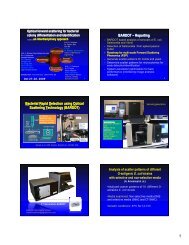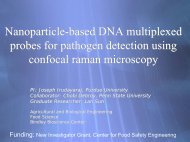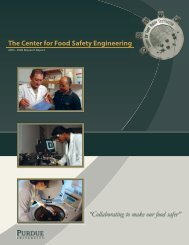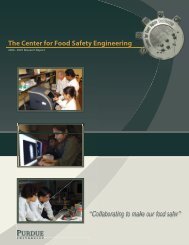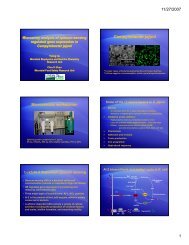Annual Report - Center for Food Safety Engineering - Purdue ...
Annual Report - Center for Food Safety Engineering - Purdue ...
Annual Report - Center for Food Safety Engineering - Purdue ...
You also want an ePaper? Increase the reach of your titles
YUMPU automatically turns print PDFs into web optimized ePapers that Google loves.
Ladisch, Bashir, Bhunia and Robinson<strong>Engineering</strong> of biosystems <strong>for</strong> the detectionof Listeria monocytogenes in foodsInvestigators: Michael R. Ladisch (Department of Agricultural and Biological <strong>Engineering</strong>), Rashid Bashir (School of Electrical and Computer<strong>Engineering</strong>), Arun Bhunia (Department of <strong>Food</strong> Science), J. Paul Robinson (Department of Biomedical <strong>Engineering</strong>)Project RationalePathogenic bacteria cause 90 percent of reported foodborneillnesses. One of these pathogens, Listeria monocytogenes,not only causes serious illness, but also can be lethal in infants,people over 60, and immune-compromised individuals. Currentmethods of detecting L. monocytogenes require 15 to 48 hours.Many small food processors and producers do not have inhousecapabilities to test <strong>for</strong> food pathogens and must send outsamples <strong>for</strong> analysis. This adds up to an additional 24 hours.Overall, two to three days typically elapses between when thefood is sampled and when the results are available. The timeto result (TTR) is problematic since some foods are consumedbe<strong>for</strong>e test results are available.Rapid and af<strong>for</strong>dable technologies to detect L. monocytogenescells directly from food and to distinguish living from deadcells are needed. This project addresses the fundamentalrequirements <strong>for</strong> developing microchip, bio-based assaysthat are transportable to the fi eld, useable in a manufacturingenvironment, and capable of rapidly detecting L.monocytogenes at the point of use. Our goals were to achievemicroscale detection of L. monocytogenes on a real-time ornear real-time basis with a TTR of four hours, and to reducethe time of culture steps with rapid cell concentration andrecovery based on membrane technology. We are addressingthe development and validation of such a microchip system thatcombines bioseparations technology—<strong>for</strong> rapid concentrationand recovery of microbial cells, and bionanotechnology—toconstruct systems capable of interrogating fl uids <strong>for</strong> pathogens.Project Objectives• Develop a system <strong>for</strong> rapid cell concentration andrecovery. Improve membrane chemistry and methodology<strong>for</strong> handling food samples high in fat and complexmolecules presented by blended hotdog, hamburger,vegetables, milk, and meat, and decrease the volume inwhich the cells are captured by selecting or constructingthe appropriate membrane design, then combining withother bioseparation techniques. For validation, use GFPengineered cells, as well as non-modifi ed cells, in mixturesof pathogenic and non-pathogenic microorganisms.• Correlate media composition to changes in growthcharacteristics and metabolism of L. monocytogenescells, and develop media that enhance the response ofpathogenic cells to detection methods. A complimentaryobjective was to improve low conductivity media<strong>for</strong> the enhanced capture and detection of stressedcells by antibodies and other bioreceptors.• Combine antibody-based capture and growth detection<strong>for</strong> the biochip. Design and microfabricate integrateddevices to combine ATP, pH, and/or direct nucleic acidand antibody-based detection on-chip using multi-channel,multi-functional designs. The goal was to obtain biochipsthat sense multiple parameters simultaneously andimprove dielectrophoresis (DEP)-based selective captureof L. monocytogenes and other pathogens in mixturesof cells and to test sensitivity and selectivity of capture.Project HighlightsWe integrated the multiple functions needed <strong>for</strong> thedevelopment and deployment of microfl uidic biochips <strong>for</strong>detecting bacterial pathogens. We integrated antibody-basedcapture of bacterial cells enhanced by dielectrophoretic<strong>for</strong>ces, bacterial culture and electrical detection of bacterialgrowth, and PCR-based detection of L. monocytogenes—allon chip. A signifi cant accomplishment was the developmentof label-free electrically amplifi ed PCR products. We showedthat impedance can be used to detect the presence of DNAmolecules in a solution without any labels directly fromthe actual PCR solution. This could lead to user-friendlyminiaturized PCR detection systems that do not need opticallabels or optical detectors.“We showed that impedance can be used to detect the presence of DNA moleculesin a solution without any labels directly from the actual PCR solution.”9<strong>Center</strong> <strong>for</strong> <strong>Food</strong> <strong>Safety</strong> <strong>Engineering</strong>






